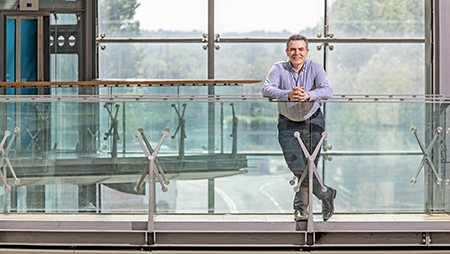December 2024
Eight things you no longer see on a plane
Long gone are the days of ashtrays and radios in your armrest, but perhaps VR games and double-decker economy seats are on their way? Aero-industry writer Paul Sillers looks back on the way things were…
1. Overhead projectors and shared screens
Before individual entertainment screens became the norm, airlines used overhead projectors in wide-bodied aircraft (using reels of 16mm acetate plastic film) to show movies. While shared screens provided some entertainment, they limited choice and could be hard to see. Individual screens and personal devices have since replaced them, offering more personalised viewing options, with touchscreens and vast movie libraries for each passenger.
2. In-flight telephones
In-flight telephones allowed passengers to make (very costly) calls during a flight, usually from seatback-mounted units in the 1990s, mainly installed on US-based carriers. As air travel evolved, these phones became outdated with the rise of personal cell phones and in-flight Wi-Fi options. Today, in-flight telephones are rarely seen, as airlines offer onboard internet services that allow for messaging and calls via the passenger’s smartphone or tablet, modernising mid-flight communication.

Smoking was once acceptable on aircraft (Mary Evans)
3. Cigarettes and ashtrays
Ashtrays were once a common feature on aircraft armrests when smoking was allowed – as late as the 1970s, cabin crew would hand out cigarettes to passengers in the cabin as if they were peanuts! Though smoking has been banned on flights since the late 20th century, remnants such as ashtrays occasionally appear on older planes. They served to prevent fires by containing lit cigarettes safely. Today, smoking is strictly prohibited on all commercial flights, making ashtrays obsolete and removed from new plane designs.
4. Onboard fax machines
In the 1980s and 1990s, several airlines offered fax machines on long-haul flights for business travellers needing real-time document sharing. Installed mainly in premium cabins, these machines allowed passengers to send and receive faxes mid-flight, bridging communication gaps before widespread internet access. However, with the rise of Wi-Fi and email, onboard fax machines became obsolete and were eventually removed from most fleets.

Pam Am advertises its in-flight headsets (Courtesy of Avid Products)
5. Pneumatic headsets
These days, nearly everyone travels with their own set of earbuds or noise-cancelling headphones. But boomers will still remember when in-flight audio used to be experienced using a ‘pneumatic headset’. This contraption looked like a medical stethoscope with plastic tubes that you plugged into the armrest. The sound quality was muffled and tinny by today’s audio quality standards.

From Cairo to London: an old Imperial Airways ticket
6. Paper tickets and boarding passes
Along with the demise of in-flight magazines, most airlines have moved away from printed content to reduce cabin weight and paper waste, opting for digital alternatives, such as bahighlife.com. Printed tickets and boarding passes, for instance, were once essential for passengers to board flights. However, technological advancements have led to app-based boarding barcodes and QR codes on our smartphones, as well as biometric gates to speed up boarding checks and reduce paper usage – and ultimately save our trees. Digital tickets and boarding passes have also made it easier for passengers to travel paper-free and with fewer items.

Spectators examine the 727-100 in Tulsa, US, with rear-mounted stairs on display (Boeing)
7. Rear-mounted stairs
Some older aircraft models (Boeing 727, McDonnell Douglas MD80 and Douglas DC9) had built-in, rear-mounted stairs under the airplane’s tail that would descend to the ground for passengers to board and disembark. These stairs allowed boarding at remote stands without requiring an airport gate. Over time, jet bridges and external airport stairs became more common, making rear-mounted stairs mostly obsolete. Today, they’re rarely seen, as newer planes prioritise using terminal gates for a streamlined boarding experience.
8. Open cockpits
Cockpits were once open or had minimal separation from the passenger cabin, allowing for interaction between passengers and pilots. However, increased security protocols and reinforced cockpit doors have been implemented. Now flight decks are highly restricted areas, with strict procedures controlling access to ensure flight safety. This separation has become a standard practice in modern aviation for safety and security.

Virtual reality goggles on a British Airways flight
…And what’s beyond the horizon?
As we say goodbye to yesteryear’s ashtrays and overhead movies, we’re already seeing a shift in the onboard experience towards personalisation. Just as passengers like to cocoon themselves in superb audio quality content, passenger-centric entertainment will soon see more immersive visuals too, as 3D and virtual-reality (VR) headsets become ubiquitous. While aircraft cabin designers ponder the possibility of double-decker seating in economy class, more realistic trends on the drawing board include smart cabin lighting that minimises jet lag, recyclable materials used for cabin furnishings that keep aviation on track towards a more sustainable future – as well as more quirky pre-flight safety videos to keep passengers both informed as well as entertained. Watch this space!
This article has been tagged Technology, Culture
More from previous issues

Introducing the man behind your in-flight menu
We unveil the process behind our most premium plates of food

A week in the life of cabin crew
Strap in as we follow Rachel Hunt on trips to Copenhagen, South Africa and our very own Global Learning Academy

15 of the best Christmas gifts for Anglophiles
These iconic British brands have something for everyone this Christmas, from the sustainable slumber queen to the cocktail connoisseur

The mini gift guide (no, literally)
We bring you the cream of the compact crop of adorable little 100ml buys for your travels

